Scottish prison population projections
Presents the first projections to be published since the COVID-19 pandemic began. These projections have been produced using ‘microsimulation’ scenario modelling which simulates prison arrivals and departures and estimates the number of individuals in prison on a particular date in the future.
This document is part of a collection
4 The Criminal Justice System in Scotland and Covid-19
The Structure of the Criminal Courts
There are three types of courts which can hear criminal cases in Scotland: the High Court, Sheriff Court, and the Justice of the Peace Court. The High Court hears the most serious cases, including all cases of rape and murder. The Sheriff Court can hear all other criminal cases. The Justice of the Peace court hears minor summary cases.
Criminal cases proceed in court in either a Summary prosecution (starting with a new case calling in the Sheriff Summary or Justice of the Peace court) or a Solemn prosecution (which begins with a new "Solemn Petition" case calling in the Sheriff court). Solemn prosecutions are for more serious criminal charges and would involve a jury when heard at a trial held in either the Sheriff Solemn court or High Court.[3]
Custodial Sentencing Powers
The following overview of the different custodial sentencing powers of Scottish courts illustrates one of the factors differentiating the court types:
- the maximum prison sentence a Justice of the Peace court can impose is up to 60 days.
- the Sheriff in a Summary case can sentence an accused person up to 12 months in prison, whereas the Sheriff in a Solemn case can sentence an accused person up to 5 years in prison.
- there is no limit on the length of prison sentence the High Court can impose.[3]
Since the end of June 2019 there has been a statutory presumption in terms of the Criminal Procedure (Scotland) Act 1995 against the imposition of a custodial sentence of less than 12 months. This is likely to mean that fewer custodial sentences will be issued by the Justice of the Peace court.
Impact of the Covid-19 Pandemic on the Justice System
As with many other areas, the Covid-19 pandemic caused significant disruption and presented significant challenges for the operation of the justice system. Compliance with public health measures during the pandemic influenced operations across the criminal justice system. The Lord Advocate issued revised guidelines on the use of police custody, and the courts had to close for extended periods or operate at reduced capacity. The necessity for non-essential court business to be temporarily suspended and the need for social distancing rules to be considered as courts re-opened affected normal activity in the court and prison systems. These measures, and the adaptations implemented in response (see Figure 3 for key events), contributed to major changes in the remand and sentenced populations, particularly between March and July 2020:
- a decreased volume of custody cases and an increased volume of undertakings reported to the Crown Office and Procurator Fiscal Service.[4]
- a reduced likelihood of an accused being remanded.[5]
- a reduced volume of concluded cases in courts, with subsequent reduction in custodial sentences issued and growth in the trial backlog.[6]
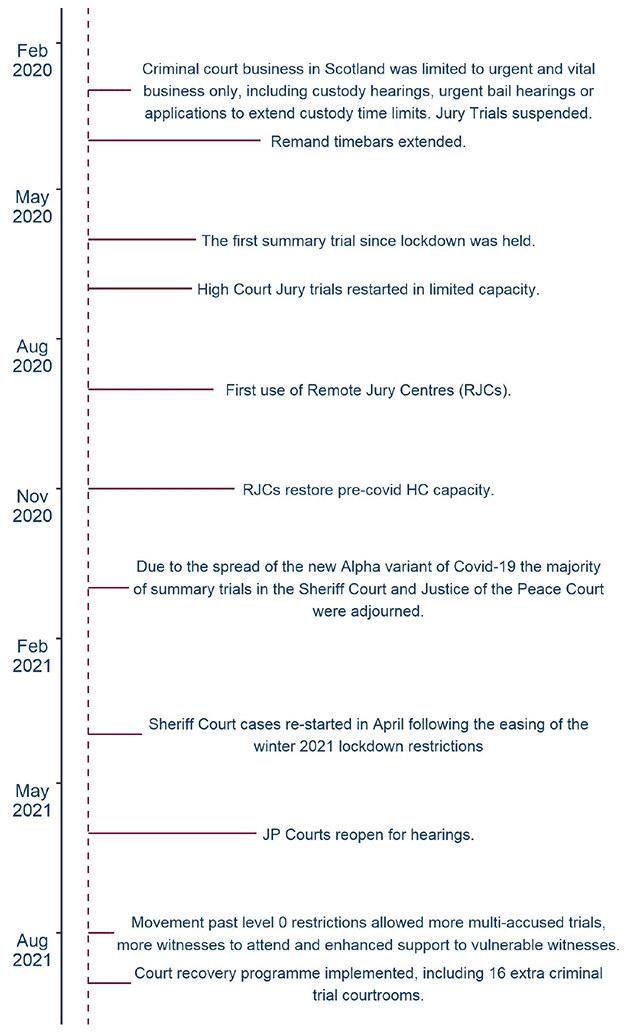
The Courts Recovery Programme
The SCTS (Scottish Courts and Tribunals Service) Courts Recovery Programme[7] implemented additional courtrooms from September 2021 to address some of the challenges faced by the justice system. The number of Sheriff Summary trial courtrooms was increased from 33 to 43, Sheriff Solemn trial courtrooms increased from 18 to 20 and High Court trial courtrooms went from 16 to 20.
SCTS monthly management information[8] shows that the national total trials scheduled across all criminal courts increased steeply, due to the effects of the Covid-19 pandemic, by around 140% from 18,100 in April 2020 to over 43,600 at its peak in January 2022. It then fell substantially to 28,000 at the end of February 2023. However, whilst the number of Sheriff Summary procedure courts scheduled trials reduced between January 2022 and February 2023, they increased in Sheriff Solemn[9] and High Court[10] by 9% and 28% respectively. Furthermore, since the pandemic, the number of scheduled trials in Sheriff Solemn grew by over 380% from around 500 in April 2020 to 2,400 in February 2023.[11] The scheduled trials in High Court grew by nearly 75% from 390 in April 2020 to 680 in February 2023. For more information on assumptions related to estimating the size of the scheduled trials backlog refer to SCTS monthly management information.[11]
The level of new business in Scottish criminal courts is determined by factors outside the control of SCTS which is prepared to adapt capacity using the best available estimates of future court demand. Primarily to address the backlog in solemn trials, the Court Recovery Programme put plans in place to introduce a further 2 High Court and 6 additional Sheriff Solemn trial courtrooms from April 2023. At the same time, linked to the reduction in the summary trials backlog, the number of Sheriff Summary courtrooms was reduced from 43 to 33.[12]
Long term trends in crime levels and the prison population
This section seeks to provide context for factors which have influenced the prison population over recent decades. These factors include levels of crime recorded, clear up rates and sentencing.
Over the past 30 years, the overall level of crimes recorded by the police in Scotland has fallen by over 50%. To illustrate this, in 1991 recorded crime reached its highest level since 1974 when it was 613,943 but by 2021-22 the total number of crimes recorded by the police in Scotland had declined to 286,464.[13] As shown in Figure 4, whilst the majority of the decline can be accounted for by a reduction in crimes of dishonesty, in the past 20 years there have been reductions for almost all crime groups, apart from sexual crimes.
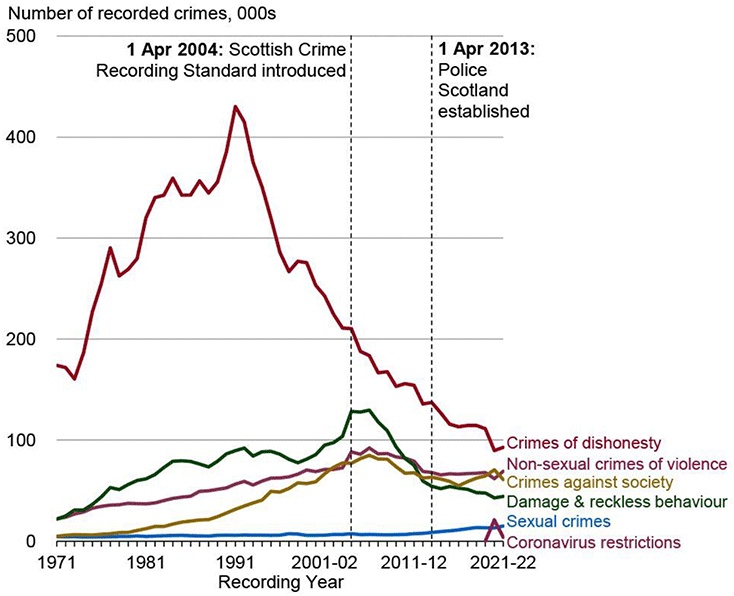
The spread of technology such as CCTV and other means of capturing evidence (e.g., widespread use of forensics) have contributed in part to the improvements in prosecution outcomes.[14] Figure 5 shows that the clear up rate (the proportion of all recorded crimes with a sufficiency of evidence under Scots law to justify consideration of criminal proceedings) in Scotland has increased from around 30% in 1991 to over 50% in 2021-22.
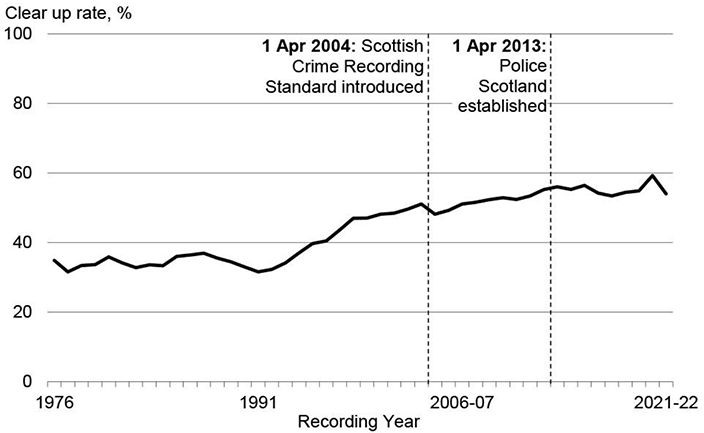
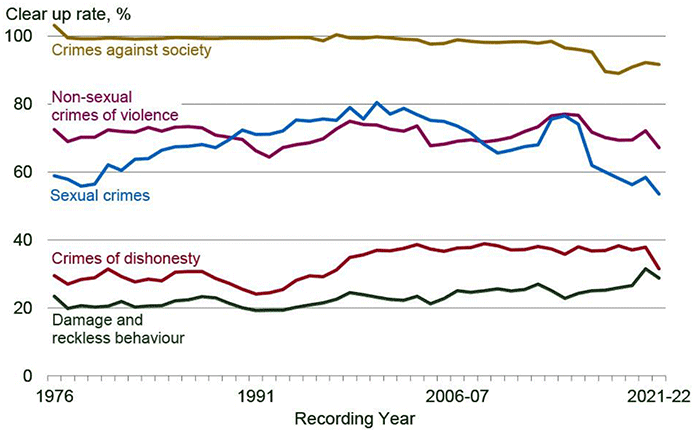
The improvement in clear up rates is in part a "substitution effect", because (as shown in Figure 4) the number of crimes associated with lower rates (such as crimes of dishonesty) has reduced by a greater proportion than the number of crimes associated with higher rates (see Figure 6). Furthermore, conviction rates have remained broadly stable, suggesting there has been no reduction in the quality of cases prepared by police and prosecution organisations despite the increase in clear up rates. This helps explain why there has been an increased demand for trials and associated sentencing, despite reduced crime rates.
In contrast to most other types of reported crimes in Scotland, which have fallen consistently over the past ten years, sexual crimes recorded by the police have increased every year to 2021-22, other than small decreases in 2019-20 and 2020-21 (see Figure 7). Although conviction rates for sexual crimes remain relatively low, the overall level of convictions for sexual crimes has increased substantially. The "downstream" impacts on both criminal justice social work and on the prison estate have been significant. Those convicted of sexual crimes now account for a far greater proportion of the prison population.
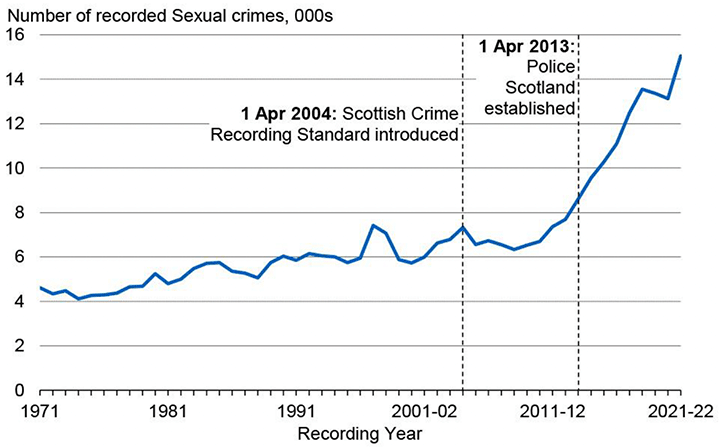
Due to a combination of factors, the custodial sentences issued have not reduced in the way that recorded crime has in the last 30 years and the average time spent in custody has been increasing. Between 2010-11 and 2019-20, the proportion of individuals who departed prison having served up to 3 months fell from 70% to 58% whereas the proportion who served a year or more increased from 7% to 10%.[16]
The prison population is changing in line with recent sentencing legislative and policy changes, alongside crime trends. Repeated below are comments from the 2019-20 prison population statistics[17] which provide the context in which recent prison population changes should be viewed:
"The data presented here cannot attest to the impact of these [legislative and policy changes] on their own, but the context is important to consider in interpreting the patterns above. For example, in terms of sentencing, the presumption against short term prison sentences was introduced in 2011, and extended to include custodial sentences of 12 months or less in 2019, with the aim of reducing ineffective use of custody and encouraging community based sentences addressing offending and rehabilitation. Changes in sentencing practices over time are observed in the Criminal Proceedings in Scotland 2018-19 report,[18] with a steady increase in custodial sentences of more than one year.
Changes to release arrangements can impact the prison population. Automatic early release for longer term prisoners ended in 2015 and use of home detention curfew[19] for short term prisoners was substantially reduced in 2018."[20]
In summary, overall levels of reported crime have been declining over the long term which has allowed increasing prioritisation of resources toward the prosecution of the most serious crimes. Alongside the use of new technology, the focus of resources on a smaller pool of crimes (especially more serious crimes) has contributed to improved detection, clear up and conviction rates. However, this "upstream" progress has meant that pressures have not diminished "downstream", with the prison population rising substantially over the past 30 years.[21]
Court Activity and the Prison Population
Over the near term, especially while the Covid-19 pandemic related scheduled trials backlog remains high, the two main factors likely to influence changes in the size of the prison population are:
- crime type breakdown of cases in the backlog, and
- court throughput.
Increasing the number of Sheriff Solemn and High Court trial courtrooms, as part of the SCTS Courts Recovery Programme, will permit more Solemn procedure Evidence Led Trials which will directly reduce the size of the backlog. However, the majority of trials called under Solemn proceedings do not result in an Evidence Led Trial, often because the individual pleads guilty before the case goes to trial. In 2019-20 the ratio of indictments to Evidence Led Trials in Sheriff Solemn court was around 5 to 1 (in the High Court it was around 2 to 1). Therefore, greater trial court capacity also indirectly causes the court backlog to reduce at a faster rate than it might otherwise. In part, this is because many individuals will choose to plead guilty in the lead up to their scheduled trial date, since they can receive a sentence discount by pleading before proceeding to a trial. Clearly, there needs to be sufficient capacity available in case the accused doesn't plead before the scheduled trial, or the sentence discounting incentive would lose some of its effect and this aspect of the justice system would lose some credibility.
Contact
Email: justice_analysts@gov.scot
There is a problem
Thanks for your feedback